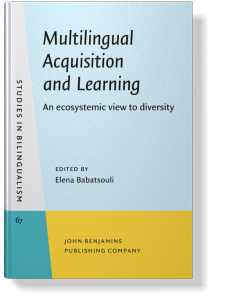Multilingual Acquisition and Learning
An ecosystemic view to diversity
The volume espouses an ecosystemic standpoint on multilingual acquisition and learning, viewing language development and use as both ontogenesis and phylogenesis. Multilingualism is inclusively used to refer to sociolinguistic diversity and pluralism. Whether speech, writing, gesture, or body movement, language is a conduit that carries meaning within a complex, fluid, and context-dependent framework that engages different aspects of the individual, the communicative interaction, communicative acts, and social parameters. Continually modified over the years to better represent its multidisciplinary scope, the sociobiological notion of language has found steady and productive ground within major theoretical frameworks, which, individually or holistically, contribute to a rounded understanding of language acquisition, learning, and use by exploring both system-internal and system-external factors and their interaction. Summoning the work of leading academics, the volume outlines the changing dynamics of multilingualism in children and adults internationally with the latest advances and under-represented coverage that highlight the ecosystemic nature of multilingual acquisition, learning, and use.
[Studies in Bilingualism, 67] 2024. ix, 645 pp.
Publishing status: Available
© John Benjamins
Table of Contents
-
Acknowledgements | pp. ix–x
-
Introduction: Remarks on an ecosystemic view of multilingual acquisition and learningElena Babatsouli | pp. 1–33
-
Section 1. General topics
-
Chapter 1. Multilingualism, creativity, and problem-solvingAshley Chung-Fat-Yim, Matias Fernandez-Duque and Viorica Marian | pp. 36–59
-
Chapter 2. The Literacy Enhancement Hypothesis in bilingual language developmentSilvina Montrul and Andrew Armstrong | pp. 60–89
-
Chapter 3. How does dyslexia impact second language acquisition? Insights from a questionnaire study with Italian and German learners of L2 EnglishIlaria Venagli and Tanja Kupisch | pp. 90–115
-
Chapter 4. Approaching Developmental Language Disorder from a Disorder within Dialects framework: A focus on dialect-informed terms, materials, and strategic scoringJanna Oetting | pp. 116–142
-
Chapter 5. Stuttering in two languages: An SFL-based exploration of bilingual stutteringAngela M. Medina, Nicole Müller and Martin J. Ball | pp. 143–168
-
Chapter 6. Multilingual data coding and analysis within Phon: A practical demonstrationYvan Rose | pp. 169–192
-
Section 2. Child speech
-
Chapter 7. Early phonological acquisition in multi-accent contextsJasper Hong Sim and Brechtje Post | pp. 194–216
-
Chapter 8. Diagnosing speech sound disorder in bilingual Vietnamese-English-speaking children: Are English-only assessments sufficient?Kate Margetson, Sharynne McLeod and Sarah Verdon | pp. 217–245
-
Chapter 9. Towards an ecosystemic view of bilingual phonological developmentRabia Sabah Meziane, Daniel Bérubé and Andrea A. N. MacLeod | pp. 246–271
-
Chapter 10. Speech and language assessment of multilingual children in HungaryFerenc Bunta, Melinda Fürész-Mayernik, Judit Bóna, Judit Navracsics, Szilvia Bátyi and Andrea Parapatics | pp. 272–294
-
Chapter 11. Dynamic assessment in phonology: A review and its application to French monolingual and bilingual childrenMargaret Kehoe and Mélodie Matrat | pp. 295–323
-
Chapter 12. Variation in phonological and morphosyntactic development in multilingual pre-schoolersIsabelle Barrière, Valerie Shafer and Suzanne van der Feest | pp. 324–345
-
Section 3. Adult speech
-
Chapter 13. Phonological features and phonetic variation in multilingual grammars: Restructuring an L3 contrastive hierarchyJohn Archibald | pp. 348–379
-
Chapter 14. Acoustic properties of word-final vowels and the acquisition of gender in Spanish-English heritage speakersLaura Colantoni and Ana T. Pérez Leroux | pp. 380–402
-
Chapter 15. Production of Spanish laterals in early sequential Spanish-English bilingualsMehmet Yavaş and Michele Suner | pp. 403–425
-
Chapter 16. A revised Natural Growth Theory of Acquisition: Evidence from L3 phonologyKatarzyna Dziubalska-Kołaczyk and Magdalena Wrembel | pp. 426–449
-
Section 4. Lexicon & grammar
-
Chapter 17. Bilinguals’ lexical choice in storytelling: Testing the weaker-links hypothesisElena Nicoladis | pp. 452–472
-
Chapter 18. Lexical development of French-Portuguese simultaneous bilinguals: Exploration of vocabulary size, word class distribution and lexical selectivitySophie Kern and Christophe dos Santos | pp. 473–499
-
Chapter 19. Morphological awareness in L2 Italian children with a migrant backgroundChiara Melloni and Maria Vender | pp. 500–528
-
Chapter 20. On the nature of operators in the grammar of L1 Chinese learners of L2 JapaneseYoichi Miyamoto, Koichi Otaki, Chie Nakamura and Noriaki Yusa | pp. 529–555
-
Chapter 21. Prosody and head directionality: On the predictability of the prosody of conjunctive coordinationJuana M. Liceras, Marco Llamazares and Yoriko Aizu | pp. 556–584
-
Section 5. Orthography
-
Chapter 22. More than spelling accuracy: Linguistic feature patterns in the misspellings of superior, average, and poor spellersRuth Huntley Bahr, Elaine R. Silliman and Laura Conover | pp. 586–612
-
Chapter 23. Phonological transfer in oral and written production among adult L2 learners of SwedishElisabeth Zetterholm | pp. 613–635
-
Language index | pp. 637–638
-
Subject index | pp. 639–645
Cited by (3)
Cited by three other publications
Babatsouli, Elena
Babatsouli, Elena
This list is based on CrossRef data as of 30 october 2024. Please note that it may not be complete. Sources presented here have been supplied by the respective publishers. Any errors therein should be reported to them.
Subjects
Main BIC Subject
CFDM: Bilingualism & multilingualism
Main BISAC Subject
LAN009070: LANGUAGE ARTS & DISCIPLINES / Linguistics / Psycholinguistics / Language Acquisition
